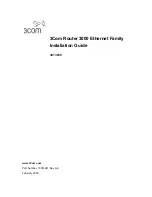
Section 150-388-124
Revision 01
Page 39
19.10
Depressing both the Mode and SEL push buttons
on the front panel for at least three seconds
initiates a Manual Loopback session. This session allows
the user to select one of eight HiGain system loopbacks.
The message, “MAN LPBK,” appears on the front panel
display followed by the message “NLO?” If the SEL push
button is pressed at this time, an NLOC loopback is
executed, changing the message from “NLO?” to “NLOC.”
If the Mode button is pressed instead of the SEL push
button, “NLO?” is replaced by “ND1?” This now allows an
NDU1 loopback to be executed (if it is a doubler
application) with the SEL push button. If this same routine
is followed, all eight loopbacks (NLOC, NDU1, NDU2,
NREM, CLOC, CDU2, CDU1, and CREM) are presented
and can be initiated in the sequence listed. Pressing the
Mode push button two more times yields the CRE and CLO
loopback options in the sequence listed. This interactive
push-button procedure permits any of the four HiGain
loopbacks to be executed/activated. The next loopback
option can be presented by pressing the Mode push button,
however, the previously executed loopback will remain
active until the SEL push button is pressed and a different
loopback is activated. If, after 30 seconds, neither button is
pressed and no loopback is in effect, the manual loopback
session terminates and the normal margin displays reappear.
If any loopback is in effect, the 30-second time-out is
inhibited. The active loopback and the manual loopback
session continue until the loopback times out in accordance
with the user-selected LBTO setting. Only one loopback
can exist at any given time. Pressing both Mode and SEL
buttons again for three seconds terminates any active
loopback, ends the Manual Loopback session, and returns
the display to normal mode. Note that these same
loopbacks can be initiated from the RS-232 maintenance
port by choosing the Loopback Mode, option “D,” from the
Main Menu. This displays the Loopback Menu (see Figure
23), from which any of the eight loopbacks can be
initiated/terminated.
20. TESTING
20.01
Table 12 through Table 17 provide step-by-step
test procedures for the HLU-388, List 2D as a
function of the loopback option selected. These procedures
allow verification of the integrity of the HDSL channels at
every module location as well as the DS1 channels to the
customer and the local DSX-1 interface.
20.02
The HLU-388, List 2D 4-character front panel
display has many useful system diagnostic
messages, which are listed in Table 18. The display turns
on when power is initially applied to the HLU-388, List 2D.
In order to conserve power, it remains on for only five
minutes when neither the Mode or SEL buttons are pressed.
The use of either button activates the 4-character display
and restarts the 5-minute power control timer.
20.03
If trouble is encountered on the HLU-388 List 2D
DSX-1 interface, verify that the HLU-388, List 2D
is making a positive connection with the mounting
assembly's connector. Also, verify that the equalizer is set
to EXT for driving external equalizers or per the
equalization settings of Table 1 for internal equalization.
All installations should be set to the largest value that does
not exceed the distance from the DSX-1 to the shelf.
20.04
The transmit and receive DSX-1 ports have
splitting access and bridging miniature 210-series
jacks, as shown in Figure 2. Connecting one cable between
the two Bridging jacks, and another between the two Line
jacks, splits the XMT and RCV and creates metallic
loopbacks toward both the DSX-1 and the HLU-388, List
2D. If plugs are inserted into both Line jacks, the BRG
jacks can be used to send and receive test patterns toward
the DSX-1.
















































